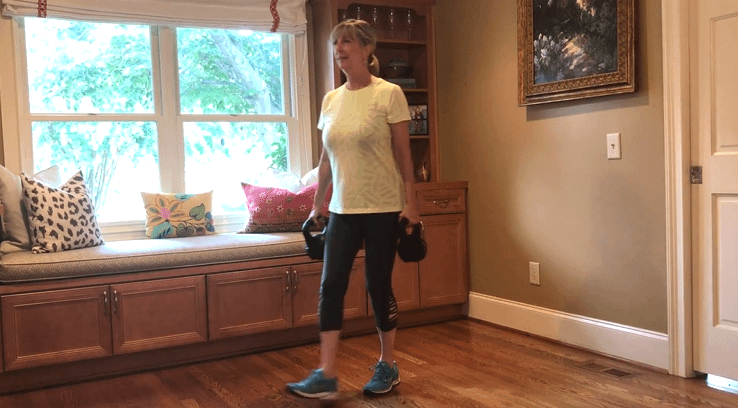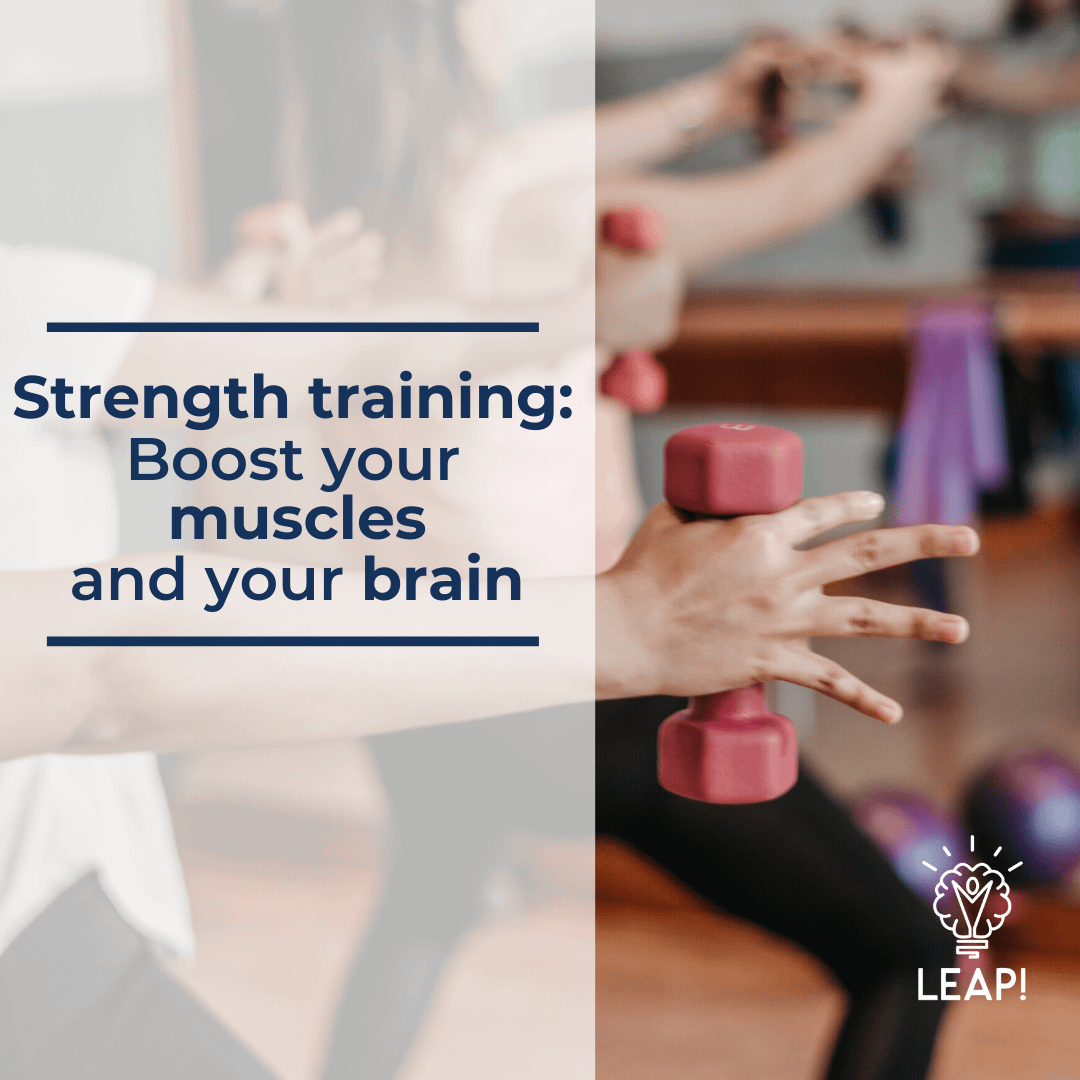Strength training, resistance training, or lifting weights may sound like modes of exercise that are exclusive to high-caliber athletes. But the truth is, resistance training can be part of anyone’s regular exercise routine. In fact, most of us can benefit from integrating resistance exercises into our workouts.
Resistance training can be done in a variety of ways—using body weight, resistance bands, exercise machines, or free weights. Numerous studies have suggested that resistance training is an effective means of helping improve balance, coordination, body composition, and energy levels.
More importantly, resistance training shows promise in helping reduce our risk of chronic diseases such as diabetes and cardiovascular disease. Research suggests resistance training can help control glucose levels and improve blood pressure about as effectively as aerobic exercise¹.
How does resistance training contribute to brain health?
In one study, participants of ages 65 to 75 who participated in strength training over the course of one year demonstrated improvements in cognitive functions such as selective attention and conflict-resolution processing². Participants strength trained either once or twice weekly, which tells us that even small doses of resistance training can be beneficial. (We’ll discuss specific recommendations for training frequency below.)
In a more recent study, just a 6-month intervention of resistance training had positive effects on the brain in participants with mild cognitive impairment (MCI)³. The results from the study were increased protection from shrinkage and degeneration in important areas of the hippocampus—the part of the brain crucial for memory formation³.
What’s striking about this particular study is that participants retained this hippocampal protection for up to 12 months after their resistance training interventions had stopped³. Thus, it has become more clear that resistance training may in fact contribute to our defense against cognitive decline.
How else can you benefit from resistance training?
Safe resistance training can be critical for maintaining good bone health.
For one, resistance training helps reduce the risk of sarcopenia, or age-related loss of muscle mass⁴. This is where a “use it or lose it” principle can be applied—the less we exercise our muscles, the more we’ll lose our ability to use them for our daily activities. Second, resistance training also helps increase bone density, reducing our risk for osteoporosis⁴.
Individuals with sarcopenia and/or osteoporosis can still participate in resistance training, and in fact are recommended to train. Guidelines from the National Strength and Conditioning Association suggest starting at a light intensity, focusing on proper form, and integrating balance exercises.
If you have sarcopenia or osteoporosis, definitely get medical clearance from your doctor before beginning a program.
Now that we’ve discussed the benefits of resistance training, let’s talk about some different types and list some tips on how to get started!
Types of strength training
1. Free Weights
Most of us will think of dumbbells and barbells when we think about resistance training—these are known free weights, one of the most common ways to strength train.
When we use free weights, our muscles work harder to stabilize the weight than when we use machines. Free weight exercises also better simulate real-life activity.
One example is the farmer’s carry, a total-body move that’s safe for most beginners. This exercise works the core, legs, and arms as you walk for about 30 seconds holding two weights at your sides. Essentially, you’re working on carrying your grocery bags with increased facility!
Exercising with free weights is versatile and provides opportunity for options. Aside from traditional dumbbells, there are medicine balls, kettlebells, sand bags, and more! If you don’t have such equipment, and don’t want to spend, consider using household items as weights, too. Milk jugs, flour sacks, or cans are a few creative ways to train at home.

2. Exercise Machines
Exercise machines can be found in any fitness facility. With proper technique and adjustments, machines may feel safer to use than free weights (though it’s important to learn from a certified professional if you’re new).
Exercise machines are especially helpful for isolating muscles that need more focus. Machines can be used to help you progress into free weight training, or as part of a workout using a mix of free weights and equipment.

3. Resistance Bands
Don’t underestimate the versatility of resistance bands—one of the most affordable and convenient pieces of exercise equipment. Many fitness facilities will have their own set of bands, but you may want to consider purchasing your own if you prefer to workout at home.
Resistance bands provide an additional challenge than free weights do—helping work more muscles in different angles. This can amp up the intensity of any basic movement!
But bands are just as beginner-friendly as they are challenging. With resistance bands, the possibilities for modifications are endless. A bicep curl, for example, can be performed seated or standing, depending on your fitness level. Different band thickness and length can also modify difficulty.
For a list of exercises you can perform with bands at home, check out this total-body workout from Silver Sneakers.
For tips on how to select resistance bands to purchase, read this short guide from VeryWellFit.
And for full, follow-along workouts, check out Senior Fitness with Meredith on YouTube here for safe, beginner exercises with resistance bands.
4. Body Weight
Last, and certainly not least, using your own body weight to resistance train is simple and effective! Better yet, body weight exercises can be performed anywhere, anytime. Check out these 5 body weight exercises from Silver Sneakers that are safe, low-impact, and easy to learn. Don’t be fooled, body weight moves can still help torch calories and work your muscles hard!
How much resistance training should you aim for?
The resistance training recommendations for healthy, older adults set by the National Strength and Conditioning Association suggest 2 to 3 resistance training sessions per week. It is recommended these days be nonconsecutive, and that sessions target different muscle groups—so as to help recovery and prevent overtraining of one muscle group.
30 to 60-minute workouts are adequate, depending on fitness level, experience, and intensity. Resistance workouts should consist of 8 to 10 different exercises. Each exercise should be performed for 8 to 15 repetitions (one set), for 2 to 3 sets.
Don’t forget to rest for 90 seconds to 3 minutes in between sets. This helps your muscles and heart rate recover to keep you pushing through!
For beginners, it’s best to start with body weight or light weight. Additionally, aim to perform closer to 8 or 10 reps when starting out. (You can increase reps as you progress.)
Ultimately, it’s much safer to begin with weight and reps you’re too comfortable with, and increase intensity, than to begin with too much weight/too many reps and get injured.

Tips to get started
Breaking into resistance training may seem intimidating and confusing, but it doesn’t have to be! Here are some tips to help get you started.
1. Seek medical clearance
Before starting any workout program, be sure to talk with your healthcare provider—especially if you are new to exercise or have a chronic condition. Resistance training is generally safe for most populations regardless of exercise experience, though recommendations will vary by age group and by overall health status. Getting medical clearance is the best step you can take towards safe exercise.
2. Invest in a personal trainer
If you are able to invest in a personal trainer we strongly recommend you do so—especially if you are a beginner.
A personal trainer will help ensure you are using proper form, progressing safely, and working towards your goals strategically. A personal trainer can also help ease some nervousness that may occur when trying something new.
Most fitness facilities have listings of trainers available and their rates. Check your local facility for more information.
3. Try a group fitness class
Train with a group! Many group fitness classes incorporate resistance exercises, and there are classes for every fitness level. While the presence of an instructor helps you exercise safely, the presence of other members helps keep you motivated and builds camaraderie.
Check the group fitness class listing at your local gym—there’s something for everyone!
4. Challenge a friend
Do you have a friend or a family member who also wants to start resistance training? Challenge them to start the journey with you! Working out with a friend not only helps keep you accountable, but allows you to give the same encouragement back.
5. Look to the web
A quick Google search can point you in the right direction for helpful workout videos and information. Here are some of our favorites!
The National Institute of Health has several YouTube playlists specifically on resistance training exercise for adults. Most exercises can be completed safely at home!
YouTube channel More Life Health Seniors has exercise videos for strength, balance, and flexibility. Many videos are 5 minutes, so consider viewing several for a full workout.Silver Sneakers is also prominent on YouTube! Click here to view their videos on different exercises. Each video gives a detailed description on how to do an exercise, so you can easily create your own workout.
6. Start small
You will thank yourself for starting out with bodyweight or lightweight, instead of going heavy and injuring yourself. Form and safety always come first! It’s better to complete less reps with good technique, than more reps with poor technique.
A good rule of thumb is to select a resistance and a number of repetitions that are most challenging for the last 2 or 3 reps in a set. Once all reps in a set become easy, you’re ready to increase weight or reps. A safe weight increase is 5 pounds for upper body movements and 10 pounds for lower body movements.
7. Record your progress
Aside from improved health, the best reward from resistance training is seeing improvement. Track the days you train—what exercises you do and how you feel.
Set SMART goals for yourself to help you stay motivated. You will be more likely to stick to something if you have a purpose!
In conclusion, resistance training is an important part of exercise for a healthy lifestyle—it’s not exclusive to athletes or young populations, and it can be performed in various modes for your individual fitness level, your individual needs.
What’s most important is that you are exercising safely and challenging yourself with small, achievable goals to improve your quality of life. This results in decreased risk!
For additional information on resistance training, we suggest checking out our own LEAP! Exercise book.
References
- Mcleod, J.C., Stokes, T., & Phillips, S.M. Resistance exercise training as a primary countermeasure to age-related chronic disease. (2019). Frontiers in physiology, 10(645). Doi: 10.3389/fphys.2019.00645
- Liu-Ambrose, T. Resistance training and executive functions: A 12-month randomised controlled trial. (2010). Arch intern med, 170(2), pp. 170-178. Doi: 10.1001/archinternmed.2009.494
- Broadhouse, C.M. Hippocampal plasticity underpins long-term cognitive gains from resistance exercise in MCI. (2020). NeuroImage: Clinical, 25. Doi: https://doi.org/10.1016/j.nicl.2020.102182
- Fragala, M.S. Resistance training for older adults:Position statement form the national strength and conditioning association. (2019). The journal of strength and conditioning research. Pdf.


